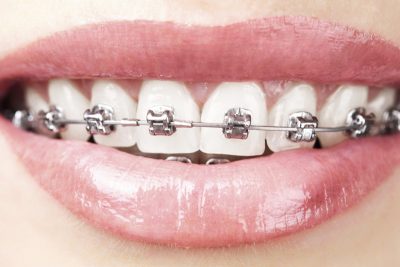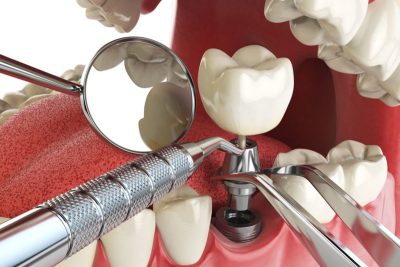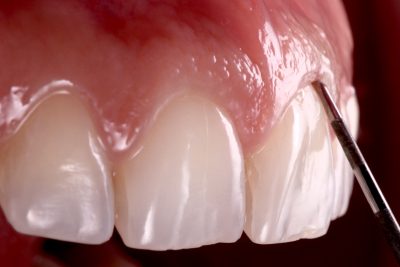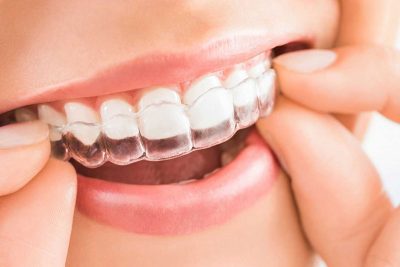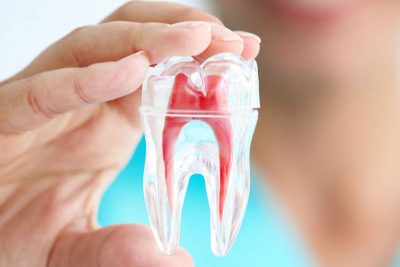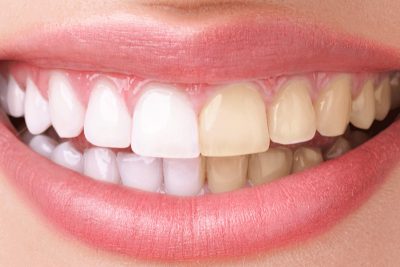Home » Treatments » Implants
Implants
Implantology and Fixed Prosthesis
In recent decades there has been a great development regarding oral rehabilitation. Improvements relate to the possibility of complete replacement of a missing tooth with an artificial tooth supported by an implant, which prevents the toothless patient from using removable dentures or the dentist having to prepare (wear) teeth that will receive crowns and fixed prostheses.
The implants are nothing but screws (usually of biocompatible metal) with different calibres and heights, with different threads to allow (most often under local anaesthesia and with their own rotary instruments) their placement in the maxillary bones, more precisely at the corresponding locations of the missing teeth.
It is a special and much studied screw.
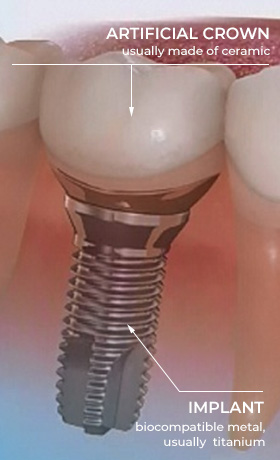
Implant-supported tooth
If a patient who needs to place an implant-supported artificial tooth paid only for the manufacture and material corresponding to the screw, half a dozen cents would be enough. However, what the patient usually pays are patents due to scientific researchers who over the past few years have promoted research so that the placement of these implants would be functional and aesthetically successful, causing no damage to the patient.
Usually, implants are made of biocompatible materials so that the organism does not identify them as strange bodies. The metal used is usually titanium. Such biocompatible material should not cause inflammatory adverse reactions and should allow intrinsic binding to the biological bone known as osseointegration. This phenomenon, which allows the implant to be anchored in the bone, takes an average of four months to complete.
This means that after placing an implant it is beneficial to wait about four months before placing the artificial tooth (crown).
When a tooth is lost, it is possible to replace it with a crown supported by an implant. Usually the implant (made of biocompatible metal) is placed in the jawbone under local anaesthesia. If all goes well, the implant attaches to the bone through a biological process called osseointegration over a period of approximately 4 months.
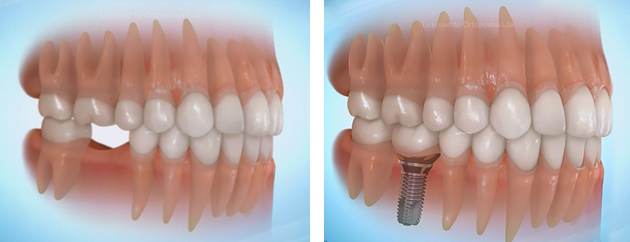
Space management to place an implant-supported tooth
Prior to placing an implant, a study of the general and local conditions is required.
It is important that the patient has good health, since the placement of implants undergoes a biological response to the surgical act and also to the material of the implant. This means that there are diseases and medications that, partially or totally, contraindicate the placement of implants, which is why it is the patient’s duty to inform the dentist about the medications and about the diseases that affect them.
Locally it is necessary to check the space conditions in the dental arch, i.e. if we need space or if there is more space to place the implant-supported tooth. For this, a clinical examination is performed, 3D scan of the oral structures and a panoramic radiograph. If the clinician finds that the space is inadequate, orthodontic appliances may need to be placed in order to move the adjacent teeth to better positions.
With adequate space and required rehabilitation, it is important to check that we have enough bone to fit and support the implant, particularly as regards thickness. Thus, we use Computerized Axial Tomography (CAT), which, besides giving us very reliable images about local bone conditions, allows in some cases, to ask for a three-dimensional protocol to guide the implantologist to safely place the implant.
In some cases, there is not enough bone to allow placing one or several implants. When this happens it may be necessary to provide the location with more bone. This can be achieved by placing artificial inert powder bone (bio-bone) or by applying a withdrawn bone graft in another part of the body (jaw, skull, etc.).

1 If space is inadequate, orthodontic braces may need to be placed to move adjacent teeth to better positions. In this case, the posterior molar tooth leaned forward occupying the place where the missing tooth was previously, which forced the appliance to upright the molar and return it to its anterior position.

2 Once the space has been reached, the implant is placed and the bone ligation (osseointegration) process takes about four months.

3 Achieving successful osseointegration, the crown is placed, thus succeeding the fixed rehabilitation of the missing tooth.
Implant placement where bone is missing
Once the radiographic and clinical situation is verified, the implantologist, after local anaesthesia, will open the surgical site to heal (scrape the bone) causing some bleeding and widen the wound separating the cortices of the bone.
It will then place inert bone powder (bio bone) into the surgical wound, mixing with blood containing cells that will help solve the inflammatory process and reshape a new bone to receive the implant.
This bone remodelling process known as osseointegration will take about four months. Only then the crown can be placed.
In the following images, we exemplify the process of placing an implant in a case where there is bone loss.
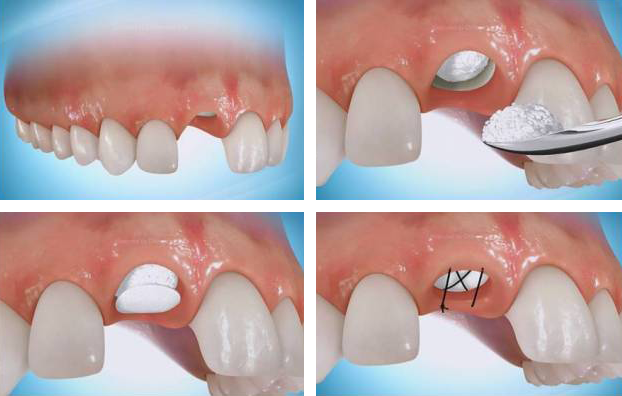
1 Laying of artificial bone powder (bio bone) covered with a membrane and then sutured.

2 After placing the bio-bone (so the patient doesn´t leave the clinic without the front tooth), we insert a removable prosthetic device with an artificial tooth. If all goes well, the blood soaks the artificial bone, and in about four months a new bone will be formed to allow the placement of an implant.

3 After four months, following the osseointegration of the implant placed in the new bone, we can place the crown.
Placing an implant where there’s extreme bone loss
In other more severe cases with extreme bone loss, it is preferable to place a bone graft where we want to place implants.
The following images illustrate the process of placing an implant in such cases.

1 In these cases, a bone graft is placed. These bone portions can be collected at the same time at various locations in the human body (jaw bones, iliac bones, skull cap bones, etc.). The bone portion is fixed with small screws, which will be removed after bone graft integration.

2 Now, four months later, we already have bone thick enough to place the implant. If everything goes accordingly, the implant will integrate the bone (osseointegration) and the crown may be fitted.
Placing implants when there’s loss of posterior teeth in the upper jaw
Another common situation has to do with the loss of posterior teeth in the upper jaw. When a patient loses these teeth too early, bone resorption can make the distance between the bony border and the nasal sinus very small, to the point that there is no bone height to place implants.

1 To achieve height in the bone, a procedure called maxillary sinus lift known as “Sinus Lift” is performed.
With local anaesthesia and under appropriate medication, the implantologist detaches the gingiva and the bony edge becomes exposed. In the lateral zone, one opens a bone window to allow the insertion of an instrument to lift the lining membrane of the sinus cavity.
2 We now fill the created space with inert artificial bone (bio-bone).
This bone will mix with the blood, which contains the repairing cells and substances essential for integration and remodelling of the new bone.
This process will take about six months, after which implants can be placed; they will take four months to be osseointegrated.
The surgical process is illustrated in the following images:



It is important to say that the placement of an implant is a technical-surgical act that requires adapting the surrounding biological tissues in the resolution of the inflammation.
Usually, being a specialized and experienced clinician, if high quality materials and own medication are used, in 95% of the cases the implant is fixed to the surrounding bone, therefore resolving the inflammatory repair process in about four months (osseointegration).
The loss of an implant is not a catastrophic event and should be understood as a local biological problem.
Usually it is removed, and after careful study within four months, the implant is replaced.
Like our own teeth, implants don’t last forever.
After several years an inflammation known as peri-implantitis can develop in the surrounding bone of the implant, which may lead to implant mobility and loss.
Ortopóvoa prides itself on having the knowledge and the vast experience to promote complex orofacial rehabilitation involving tooth-supported and implant-supported teeth.
In addition, we have our own laboratory and technicians for fabricating ceramic crowns and veneers and guarantees full coverage and assistance of our treatments.


